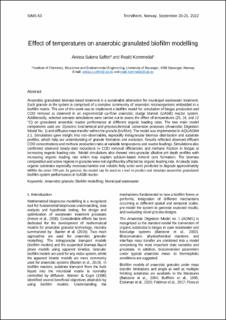| dc.contributor.author | Safitri, Anissa Sukma | |
| dc.contributor.author | Kommedal, Roald | |
| dc.date.accessioned | 2023-04-12T08:55:49Z | |
| dc.date.available | 2023-04-12T08:55:49Z | |
| dc.date.created | 2022-11-08T10:13:03Z | |
| dc.date.issued | 2022 | |
| dc.identifier.citation | Safitri, A. S., Kommedal, R. (2022). Effect of temperatures on anaerobic granulated biofilm modelling. Linköping Electronic Conference Proceedings 2022. | en_US |
| dc.identifier.issn | 1650-3686 | |
| dc.identifier.uri | https://hdl.handle.net/11250/3062557 | |
| dc.description.abstract | Anaerobic granulated biomass-based treatment is a sustainable alternative for municipal wastewater treatment. Each granule in the system is comprised of a complex community of anaerobic microorganisms embedded in a biofilm matrix. The aim of this work was to implement a biofilm model for simulation of biogas production and COD removal as observed in an experimental up-flow anaerobic sludge blanket (UASB) reactor system. Additionally, selected scenario simulations were carried out to assess the effect of temperatures (25, 16, and 12 °C) on granulated anaerobic reactor performance at different organic loading rates. The two main model components used are: Dynamic biochemical and physicochemical conversion processes (Anaerobic Digestion Model No. 1) and diffusive mass transfer within the granule (biofilm). The model was implemented in AQUASIM 2.1. Simulations gave insight into non-observables, especially intragranular biomass distribution and substrate profiles, which help our understanding of granule formation and evolution. Results reflected observed effluent COD concentrations and methane production rates at variable temperatures and reactor loadings. Simulations also confirmed observed steady-state reductions in COD removal efficiencies and methane fraction in biogas at increasing organic loading rate. Model simulations also showed intra-granular alkaline pH depth profiles with increasing organic loading rate which may explain calcium-based mineral core formation. The biomass composition and active regions in granules were not significantly affected by organic loading rate. At steady state, organic substrates especially monosaccharides and volatile fatty acids were predicted to degrade approximately within the outer 100 μm. In general, the model can be used as a tool to predict and simulate anaerobic granulated biofilm system performances in UASB reactor. | en_US |
| dc.language.iso | eng | en_US |
| dc.publisher | Linköping University Electronic Press | en_US |
| dc.rights | Navngivelse 4.0 Internasjonal | * |
| dc.rights.uri | http://creativecommons.org/licenses/by/4.0/deed.no | * |
| dc.title | Effect of temperatures on anaerobic granulated biofilm modelling | en_US |
| dc.type | Peer reviewed | en_US |
| dc.type | Journal article | en_US |
| dc.description.version | publishedVersion | en_US |
| dc.rights.holder | The authors | en_US |
| dc.subject.nsi | VDP::Teknologi: 500 | en_US |
| dc.source.journal | Linköping Electronic Conference Proceedings | en_US |
| dc.identifier.doi | 10.3384/ecp192030 | |
| dc.identifier.cristin | 2070411 | |
| cristin.ispublished | true | |
| cristin.fulltext | original | |
| cristin.qualitycode | 1 | |

